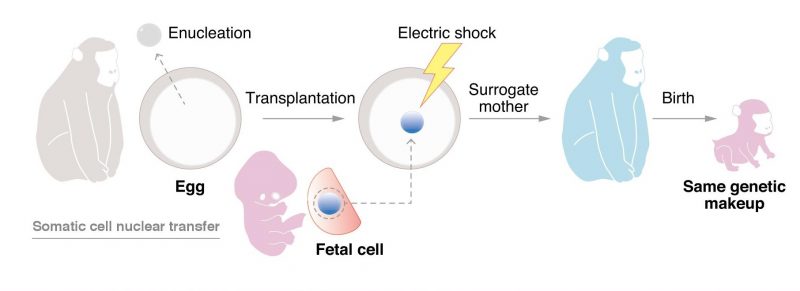Monkeying with clones
In February, the journal Cell published a paper about the first monkey clone. While other animals have been cloned in the past, including Dolly the Sheep in 1997, none are as evolutionary close to humans as monkeys. The researchers used somatic cell nuclear transfer, the method reported by Dr. John Gurdon in 1962 to clone a frog and led him to share the Nobel Prize with Shinya Yamanaka in 2012. Although the cloning rate remains frustratingly low, the ability to clone monkeys could lead to advanced animal models for the study of human diseases.
Of course, animal cloning is wrought with controversy, and the ability to clone monkeys suggests the ability to clone humans is not too far away. Many people have already looked at cloning as a way to immortalize pets. People may now start sensing an opportunity to clone humans, giving dystopic hope that the preservation of cells could reanimate a tragically lost child. It also would give possibility to someone being cloned unwittingly should their cells be preserved but used in ways without their consent.
Somatic cell nuclear transfer involves the removal of the nucleus of a cell and its insertion into an enucleated egg. The egg provides an environment in which the nucleus is reprogrammed so that the egg can develop into a functional living organism. Interestingly, the research group found that the quality of the somatic cell nuclear transfer depended on the age of the cells from which the nuclei were taken. Nuclei from adult cells led to monkey clones with severe abnormalities, whereas nuclei from fetal cells resulted in healthy clones. However, it should not be assumed that just because monkey clones are possible, we are on the cusp of human clones. It took 30 years to go from frog clones to sheep clones, and another 20 years to reach monkey. Moreover, laws throughout the world strictly prohibit cloning experiments with human cells, and the unestablished risks to both the mother carrying the cloned fetus and the fetus itself only add more weight to the arguments against these experiments.
Nevertheless, the accomplishment reported in Cell has important implications. Monkey research is permitted in Japan if the researcher can establish that no other viable experiments are available. The risks to the monkeys – both the offspring and mother – in these cloning experiments are unknown. Therefore, even these experiments must overcome high ethical standards before receiving permission. Policymakers have an interesting challenge before them.

Written by Tsutomu Sawai
